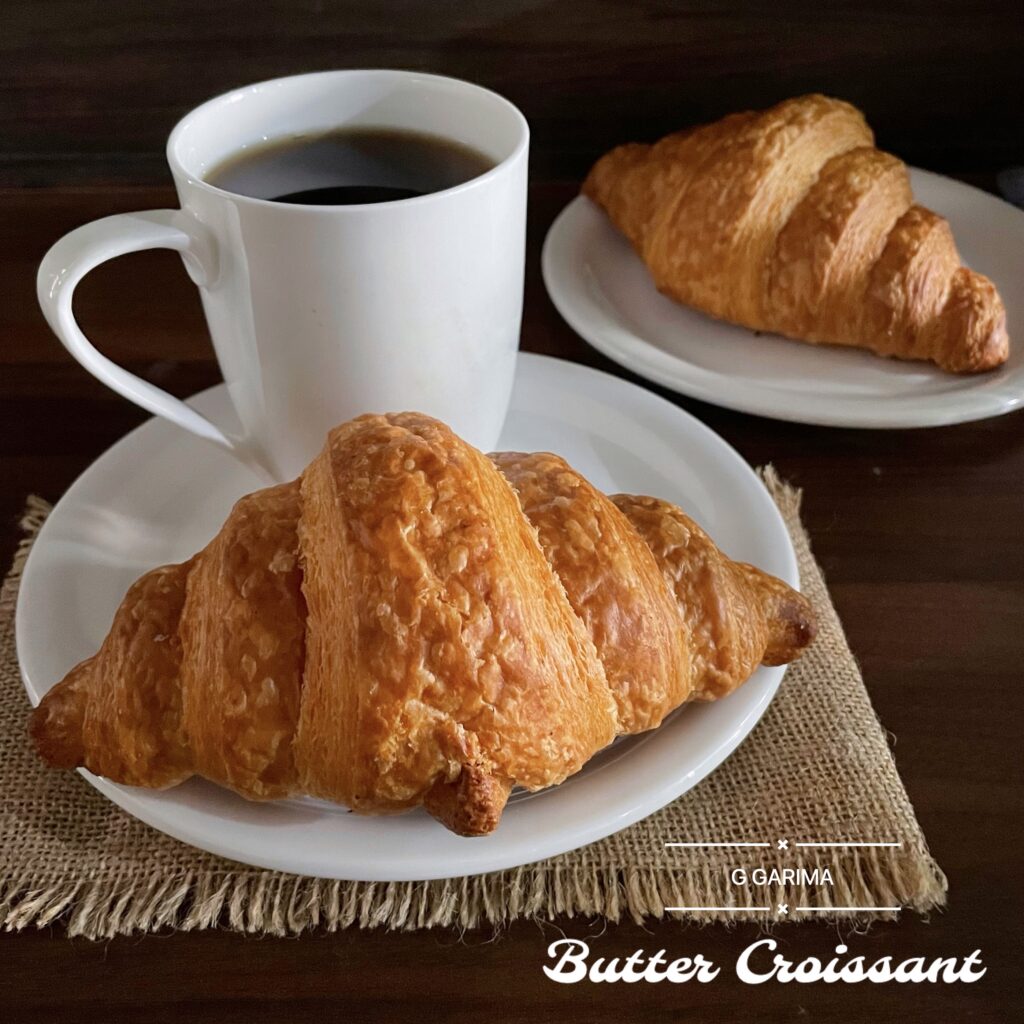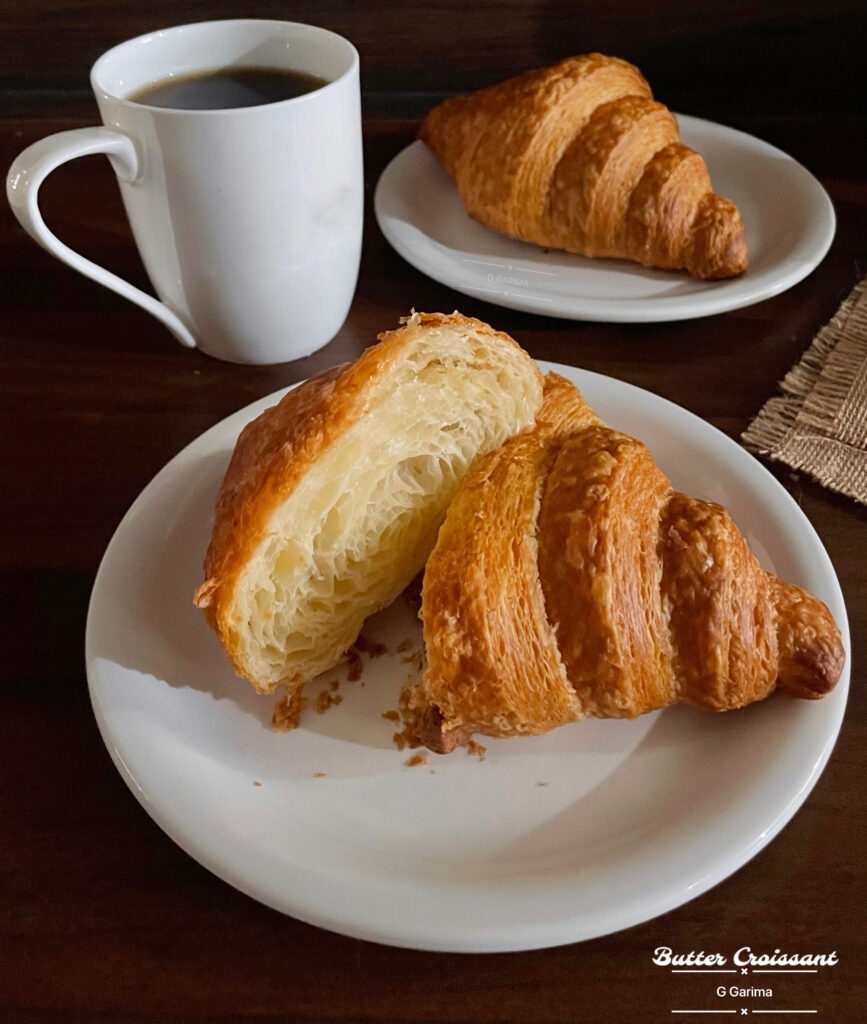26 March, 2023
CROISSANT | Laminated Dough

Croissant – Classical French Pastry
I can’t imagine a better way to start my day than having a Croissant.
Flaky on the Outside, Soft and Buttery on the Inside with a delicate crunch, Croissant is made with “Laminated Dough”. This is one of my favorite “Classical French Pastries”.
Naming:
The “French” word “Croissant” actually translates to “Crescent” in English. Many historical experts believe French Croissants evolved from Austrian Kipferl, a buttery and often sweet baked good shaped like a Crescent Moon.
According to the popular legend Kipferl dates back to 1683 when a baker heard the Ottoman Turks tunneling beneath Vienna to lay siege to it. He sounded the alarm to save the city and created Kipferl to celebrate this victory. Its curved shape supposedly symbolizes the Crescent Moon emblem on the Ottoman Flag.
Kipferl eventually migrated to France and evolved into what we now know and love as the Croissant.

What Is “Laminated Dough” ?
“Laminated Dough” is a technique of creating multiple, alternate layers of Dough and Fat (Butter) by rolling and folding it several times.
“Laminated Dough” has several layers of Butter overlapping the Dough. This is what allows it to expand in the oven and gives an end product with several beautiful layers.
Croissant, Puff Pastry and Danish all these are made with “Laminated Dough” which means there is going to be alternate layerings of Butter and Dough in these French Pastries. Laminated Dough is a base recipe we need to make some Pastries.
Making Process:
Croissant is made with similar process as of Puff. To read in detail, Click here https://foodiegarima.com/puff-pastry-laminated-dough/
The process of making Croissant takes practice and a lot of patience.
Difference Between Croissant And Puff Pastry:
Croissant and Puff both have the same process of making. The only difference between these two is Croissant has Yeast but Puff doesn’t have yeast. Croissant Dough is a bit firm but Puff Dough is not.
Puff pastry is a little bit hard but Croissant is not that much hard. The reason why Croissant is a little bit softer is because Croissant Dough has butter but Puff Dough doesn’t have butter.
But not all Croissant recipes have butter in the dough.
Puff has alternate layers of Dough and Butter but there is not any butter in its dough. Puff Dough is a Lean Dough without Butter and Yeast in it.
Ingredients:
Croissant consists of 8 ingredients.
Milk, Flour, Dry Butter, Egg, Salt, Sugar, Yeast, Water.
The Making of Croissant:
The Croissant Pastry making consists of two parts:
Part (1). The Beurrage (Butter), Part (2). The Detrempe (Dough)
Part (1). The Beurrage (Butter Slab):
Ingredients: 3 cups of Unsalted Dry Butter, 1 cup All Purpose Flour.
Dry Butter is important. So add a small amount of Flour to the Butter. Flour absorbs the moisture and makes the butter dry and flexible to work with while Laminating.
Mix these ingredients well in the food processor. Chill it for a couple of hours.
Incorporate this Butter Slab into the dough through a process of Rolling and Folding.
Part (2). The Detrempe (Puff Pastry Dough):
Dough acts as the body of Croissant pastry.
All Purpose Flour, Sugar, Salt, Yeast, Unsalted Butter, Ice Cold Water, Milk.
Kneading: Knead or make a dough by mixing these ingredients using a food processor until the dough comes together but is still cool.
Don’t overwork the dough. Don’t knead it for too long as we don’t want to encourage too much Gluten development. Gluten shouldn’t be fully developed.
Overworking the dough can affect the moisture and also tighten the dough.
Let the dough rest and chill in the deep freezer after kneading. This is important to rest the dough.
Resting the dough helps in relaxing the Gluten strands and starches in the flour to absorb liquid and make it ready for Lamination.
Lamination Process:
- Roll the dough into a rectangle about a quarter inch. If the dough is hard to roll out then wrap it in plastic and rest in the fridge for about 15 minutes
- Add butter in between the sheets of dough.
- Wrap the dough around the fat.
- Then roll out and fold over on itself several times to create the layers of fat and dough. Let the dough rest after every roll and fold.
- More than one fold ends up in shrinkage and tearing of dough. When we roll the dough, it stretches and then tries to shrink after rolling. So it is necessary to chill the dough to avoid shrinkage after every fold.
Enclosing The Fat:
Before enclosing the fat, the texture (firmness) and temperature of both the dough and fat needs to be similar.
- If the Dough is too Soft and Butter is too Cold then there are chances for the Dough to tear and Fat might not spread evenly between the layers.
- If the Dough is too Cold and Butter is too Soft then Butter can ooze out of the layers.
Shaping:
- Cut the dough diagonally towards the bottom left corner. Continue cutting the rest of the dough until you leave with no dough to cut.
- Make a slit in the middle of the base of each triangle and then roll them up to create an iconic crescent shape.
- Make sure to roll as tight as possible without applying too much pressure so that the croissants will hold its shape as it proofs and bakes.
Proofing:
Before we get to baking, we have to do proofing of Croissant Pastry.
Add boiled water to a small vessel and place it on the baking tray. Moisture is key to prevent the dough from drying out.
Note:
- Resting and Proofing is important for croissant dough as it has yeast in it. It takes 2-3 hours for better proofing.
- Better the proofing, nicer the honeycomb is going to be. Honeycomb means, when we cut the croissant the layers look like a honeycomb.
- The dough containing yeast must be kept in the deep freezer to retard the proofing process. Because we don’t want the yeast to develop. If we don’t keep it in a deep freezer to get cold then yeast develops and the dough will rise. Thin layers will not be formed and we’ll get all thick layers only.
- Before baking, brush the croissants with egg wash to get a shiny copper brown shell.

